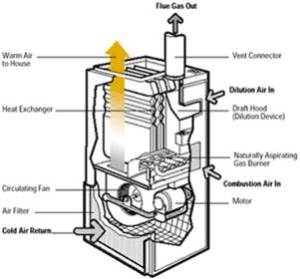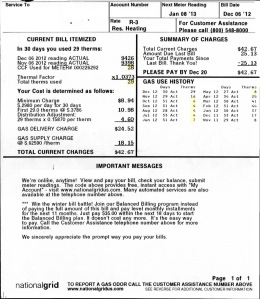How good a job does your house do at conserving the energy that you pay for to condition it? Your comfort is the first determiner of that. Are you comfortable in your house? All year ‘round? Are you too cold or too hot? Do you feel drafts? Do you feel clammy in the summer or dried out like a prune in the winter?

What sort of conditioning system are you dealing with? Most of the United States uses conditioned air systems that consist of a central box with a big blower in it and some conditioning elements. When the house needs heat, the heating element heats up, the blower turns on, and pushes the air across the heating element where it picks up the heat. The heated air is pushed into the ducting and out through registers into the rooms. The conditioned air moves through the rooms and back to return grilles, back into the ducting, and back through a filter to the blower where it starts all over again.
If you live in a place where it is hot, the system works basically the same way but drawing the air through a cooling coil in the air handler where it chills the air and in the process causes the moisture in the air to condense so that the air returning to the house is drier.
Some houses have baseboard hot water systems with little radiators running around the room. Some houses are heated by electric radiators. Some older houses are heated by steam radiators. Some houses are heated by radiant coils in the floor or ceiling. There are solar heated houses and wood stove heated houses. (More about heating and cooling systems later.) You’re probably aware of what sort of heating or cooling system you have. If you’re not, you probably ought to find it and get familiar with it.
If you get regular, natural gas bills, you have a good record of how much energy you are using, so let’s start with natural gas to start getting a handle on the energy efficiency of your house.
First, you have to know if you use gas for more than heat. Do you have a gas stove, gas dryer, or gas water heater? Is your water heater a separate device from your house’s heating system? What you want to know is how much energy is used just for heating. You need to figure out your energy baseline – how much energy you use every month of the year for functions other than just heating the air. If you look at your gas bill for the past year (if you don’t have a full year you can work around this), during the warm weather the gas consumption will obviously go down. Pick the months when the house probably used little or no gas for heating.
 So get your gas bill and let’s extract some information. The first thing you have to do is be able to understand your gas bill! Most of us just get the bill, look at the amount, and pay it. But there’s more information there. Take a look at the example bill here[1].
So get your gas bill and let’s extract some information. The first thing you have to do is be able to understand your gas bill! Most of us just get the bill, look at the amount, and pay it. But there’s more information there. Take a look at the example bill here[1].
On the left it says, “In 30 days you used 29 therms”. A therm is equal to 100,000 BTUs. (BTU stands for British Thermal Unit. It’s about the same amount of energy as there is in a standard sized kitchen match. 100,000 is a lot of kitchen matches!)
- Natural Gas 100,000 BTUs/Therm
- Fuel Oil 139,000 BTUs/Gallon
- Electricity 3412 BTUs/kWH
- Propane 91,500 BTUs/Gallon
The bill tells you how they calculated that by subtracting the start reading from the end reading, arriving at a difference of 28 CCF. (CCF are one hundred cubic feet.) But not all natural gas has the same heating capability like different grades of gasoline, so they adjust the CCF with a Thermal Factor (in this case 1.0373) to come up with therms. The 29 that are listed on the bill.
Then they charge a minimum of $0.298 per day just because the house is connected to the gas line. They charge $0.3786 per therm for the first 29 therms. Then they add $0.1587 per therm for a “distribution adjustment”. All of that is just to get the gas to the house. Then they charge for the gas: $0.6259/therm. You have to include all of the delivery charges to figure out what the fuel is actually costing you per therm: in this case $1.47/therm.
Over on the right side of the bill are the Summary of Charges and the Gas Use History. As you can see, only 4 therms per month were used each month during July, August, September, and October. 8 therms were used in May and 7 in June. This house has gas heat, hot water, and range. So during the warm months we can figure that no gas was used to heat the house. So if we add up May, June, July, August, September, and October (6 months), we get 31 therms. We divide that by six to get an average, and we get about 5 therms. So we can figure that on average, throughout the year about 5 therms are used every month for things other than heating. If we add up all the therms for a year (223 in this case), we can subtract 60 therms for things other than heat, and arrive at a grand total of 163 therms that are used to heat this house. 5 therms per month is considered the baseline.
Just taking it one step further, if the price of gas stayed the same and the weather stayed the same for a year, it would cost 163 times $1.47 or about $240/year to heat this little house.
Next time: Total U Value
http://www.HeyokaSolutions.com
[1] Utility bills certainly vary. Here’s a link to the Unitil site and their bill explanation: http://www.unitil.com/manage-my-account/understanding-my-bill-2
You should check out your own utility for variations.
